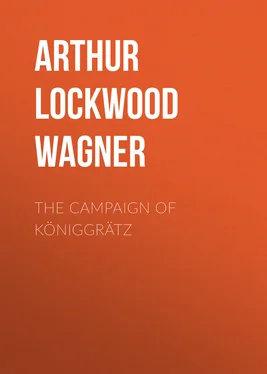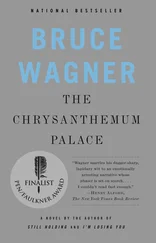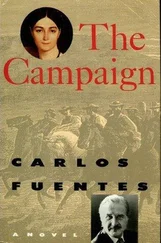Arthur Wagner - The Campaign of Königgrätz
Здесь есть возможность читать онлайн «Arthur Wagner - The Campaign of Königgrätz» — ознакомительный отрывок электронной книги совершенно бесплатно, а после прочтения отрывка купить полную версию. В некоторых случаях можно слушать аудио, скачать через торрент в формате fb2 и присутствует краткое содержание. Жанр: foreign_prose, История, foreign_edu, foreign_antique, на английском языке. Описание произведения, (предисловие) а так же отзывы посетителей доступны на портале библиотеки ЛибКат.
- Название:The Campaign of Königgrätz
- Автор:
- Жанр:
- Год:неизвестен
- ISBN:нет данных
- Рейтинг книги:4 / 5. Голосов: 1
-
Избранное:Добавить в избранное
- Отзывы:
-
Ваша оценка:
- 80
- 1
- 2
- 3
- 4
- 5
The Campaign of Königgrätz: краткое содержание, описание и аннотация
Предлагаем к чтению аннотацию, описание, краткое содержание или предисловие (зависит от того, что написал сам автор книги «The Campaign of Königgrätz»). Если вы не нашли необходимую информацию о книге — напишите в комментариях, мы постараемся отыскать её.
The Campaign of Königgrätz — читать онлайн ознакомительный отрывок
Ниже представлен текст книги, разбитый по страницам. Система сохранения места последней прочитанной страницы, позволяет с удобством читать онлайн бесплатно книгу «The Campaign of Königgrätz», без необходимости каждый раз заново искать на чём Вы остановились. Поставьте закладку, и сможете в любой момент перейти на страницу, на которой закончили чтение.
Интервал:
Закладка:
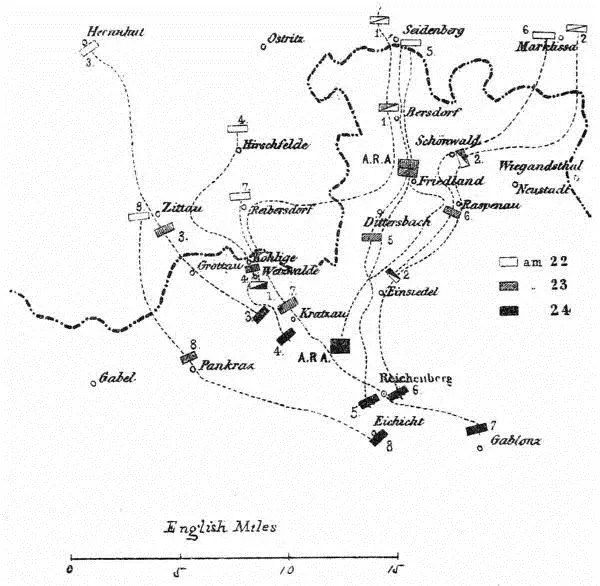
N o. 2.
1 st. ARMY ON 22 ND., 23 RD. & 24 TH. JUNE.
Two railway lines lay in the theater of war, and were of great importance to the contending armies. One line ran from Vienna, via Kosel, Breslau and Görlitz, to Dresden. The other connected the Austrian capital with Prague, via Olmütz (or Brünn) and Bömisch Trübau. The two lines were joined by a railway from Dresden to Prague, and by one which, running from Löbau to Turnau, branched from the latter point to Prague and Pardubitz. These railways connected with others leading to all the important cities of Prussia. The two Prussian armies could cover their railway communications while advancing; but the Prague-Olmütz line, which was of vital importance to the Austrian army, ran parallel to, and dangerously near, the Silesian frontier, and was not covered by the Austrian front during the operations in Bohemia.
The Prussian advance began on the 20th of June. The Army of the Elbe marched from the vicinity of Dresden, via Stolpen, Neustadt, Schluckenau and Rumburg, to Gabel. As the greater part of this march had to be made by one road, it required six days, though the distance was only 65 miles. The First Army had concentrated at Zittau, Herrnhut, Hirschfelde, Seidenberg and Marklissa. From these points it began its march on the 22d of June, each division marching by a separate road; and on the 25th it was closely concentrated around Reichenberg. The entire Prussian front was now reduced to about 100 miles, and Herwarth Von Bittenfeld was only twelve miles from Frederick Charles.
It would have been dangerous in the extreme for the Crown Prince to begin his march while Von Benedek held six corps in hand to hurl upon him. The passage of the Second Army through the defiles depended on surprise; and in the face of a superior and concentrated army, it would have been a desperate undertaking. It was necessary, therefore, to distract the plans of the enemy by false maneuvers, and to wait for Frederick Charles to menace the Austrian left, on the Iser, before beginning the forward movement with the Second Army. With these objects in view, the VIth Corps was ordered to push forward towards Olmütz, and Frederick Charles received the following instructions from Von Moltke: “Since the difficult task of debouching from the mountains falls upon the Second, weaker, Army, so, as soon as the junction with Herwarth’s corps is effected, the First Army must, by its rapid advance, shorten the crisis.” The VIth Corps moved from Neisse into the Austrian dominions as far as Freiwaldau, where its advanced-guard had a successful skirmish with a party of Austrian cavalry. This corps was supposed by the Austrians to be the advanced-guard of the Crown Prince’s army marching upon Olmütz; and the demonstration had the effect of holding a large force of Austrians between Hohenmauth and Bömisch Trübau, where it could not be used to oppose the real advance of the Second Army.
The Crown Prince’s army was to move as follows:
The Ist Corps 3 3 It may be of assistance to the reader, in the following pages, to note that the divisions in the Prussian army are numbered consecutively throughout the several army corps. Thus, the Ist Corps consists of the 1st and 2d Divisions; the IId Corps, of the 3d and 4th Divisions; the VIth Corps, of the 11th and 12th Divisions, and so on.
via Liebau and Trautenau, to Arnau;
The Guards, via Neurode, Braunau, Eypel, to Königinhof;
The Vth Corps, via Glatz, Reinerz, Nachod, to Gradlitz;
The cavalry, from Waldenburg, via Trautenau, to Königinhof.
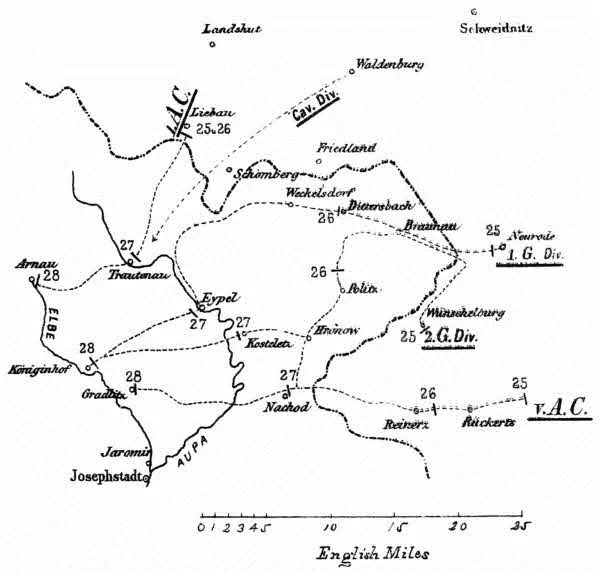
N o. 1.
PROPOSED ADVANCE OF 2 ND. ARMY FROM 25 TH. TO 28 TH. JUNE.
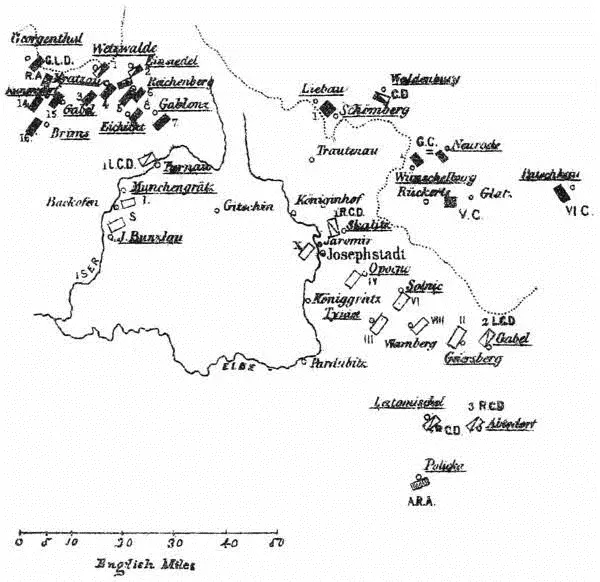
N o. 3.
POSITION OF BOTH ARMIES ON THE EVENING OF THE 25 TH. JUNE.
The VIth Corps, having made the diversion to Freiwaldau, was withdrawn to Glatz and Patschkau, from which points it was to follow the Vth. A corps of observation, consisting of two regiments of infantry, one of cavalry, and a light battery, was detached at Ratibor to make demonstrations against Austrian Silesia. In case this detachment should encounter a large force of the enemy, it was to fall back upon the fortress of Kosel. During the campaign an unimportant war of detachments was carried on in this region, generally to the advantage of the Prussians.
JUNE 26TH
On the 26th of June the Army of the Elbe marched upon Niemes and Oschitz. The advanced-guard encountered an Austrian outpost near Hühnerwasser, and drove it back after a sharp skirmish. The main body of the Army of the Elbe bivouacked at Hühnerwasser, with outposts towards Weisswasser, Münchengrätz and Gablonz. In the evening there was another brisk outpost fight in the direction of Münchengrätz, in which the Austrians were again worsted.
In the First Army the advance on this day was begun by General Von Horn, whose division had held the outposts the night before. At Liebenau Von Horn struck the Austrians, whose force consisted of a small body of infantry, four regiments of cavalry and two batteries of horse artillery. Driven out of the village, and from the field where they next made a stand, the Austrians retreated across the Iser, via Turnau, to Podol. The First Army now occupied a position extending through Reichenberg, Gablonz, Liebenau and Turnau; Von Horn’s division extending down the Iser from Turnau, with outposts near Podol. Free communication—in fact a junction—was now established with the Army of the Elbe, one division of which occupied Bömisch Aicha.
An attempt made by a company of Prussian riflemen to seize the bridges at Podol, about dusk in the evening, brought on a sharp fight. The forces on each side were reinforced until parts of two Prussian and two Austrian brigades were engaged. A stubborn infantry battle was carried on by moonlight until 1 o’clock in the morning, when the Austrians retreated towards Münchengrätz. By this victory the Prussians secured the passage of the Iser at Podol; the shortest line to Gitschin was opened to them; the communications of Count Clam-Gallas with the main army were threatened; and a plan which he had formed to riposte upon the Prussians at Turnau was thwarted.
We will now turn to the Second Army. On this day the Ist Corps concentrated at Liebau and Schomberg, ready to cross the frontier. The Vth Corps was at Reinerz, about twenty miles from the Ist. The Guard Corps, which had just crossed the frontier, in front of Neurode, midway between the two corps, was in a position to support either. The VIth Corps was at Landeck and Glatz, part of its cavalry being sent forward to cover the left of the Vth Corps and maintain communication between the two. After passing the mountains, the entire army, pivoted on Nachod and Skalitz, was to wheel to the left, seize the Josephstadt-Turnau railway, and form a junction along that line with the armies of Frederick Charles. On the evening of the 26th, the advanced-guard of the Vth Corps occupied Nachod. The distance between the Crown Prince and Frederick Charles had now been reduced to about fifty miles, while the distance between the extreme corps of the Austrian army was about the same. Von Benedek’s strategical advantages were already beginning to disappear. The Prussian demonstrations towards Olmütz had caused the Austrian IId Corps to be retained dangerously far to the right; Count Clam-Gallas was struggling against superior numbers on the Iser, and Von Benedek had only four corps with which he could immediately oppose the four corps of the Crown Prince.
Читать дальшеИнтервал:
Закладка:
Похожие книги на «The Campaign of Königgrätz»
Представляем Вашему вниманию похожие книги на «The Campaign of Königgrätz» списком для выбора. Мы отобрали схожую по названию и смыслу литературу в надежде предоставить читателям больше вариантов отыскать новые, интересные, ещё непрочитанные произведения.
Обсуждение, отзывы о книге «The Campaign of Königgrätz» и просто собственные мнения читателей. Оставьте ваши комментарии, напишите, что Вы думаете о произведении, его смысле или главных героях. Укажите что конкретно понравилось, а что нет, и почему Вы так считаете.
